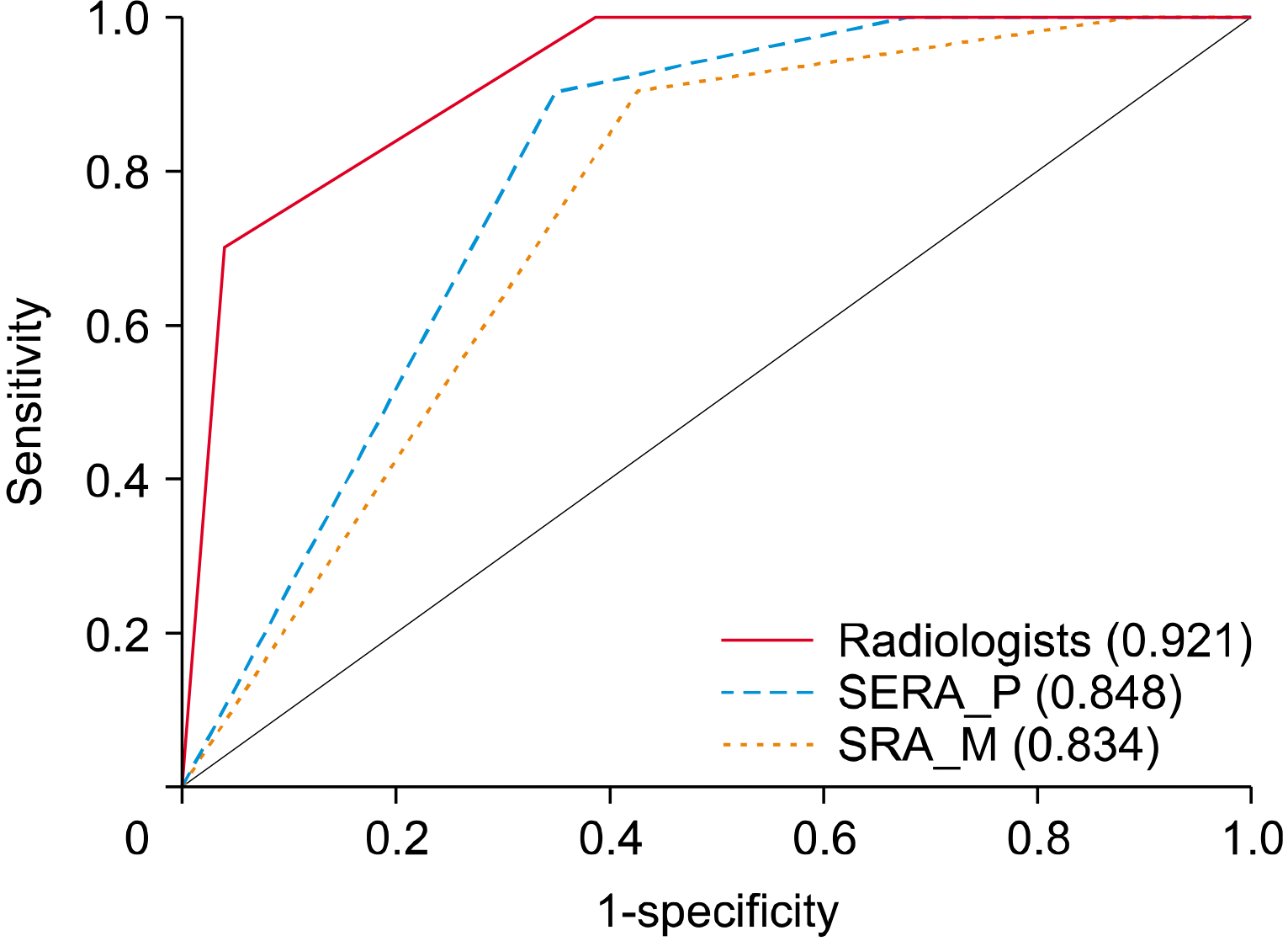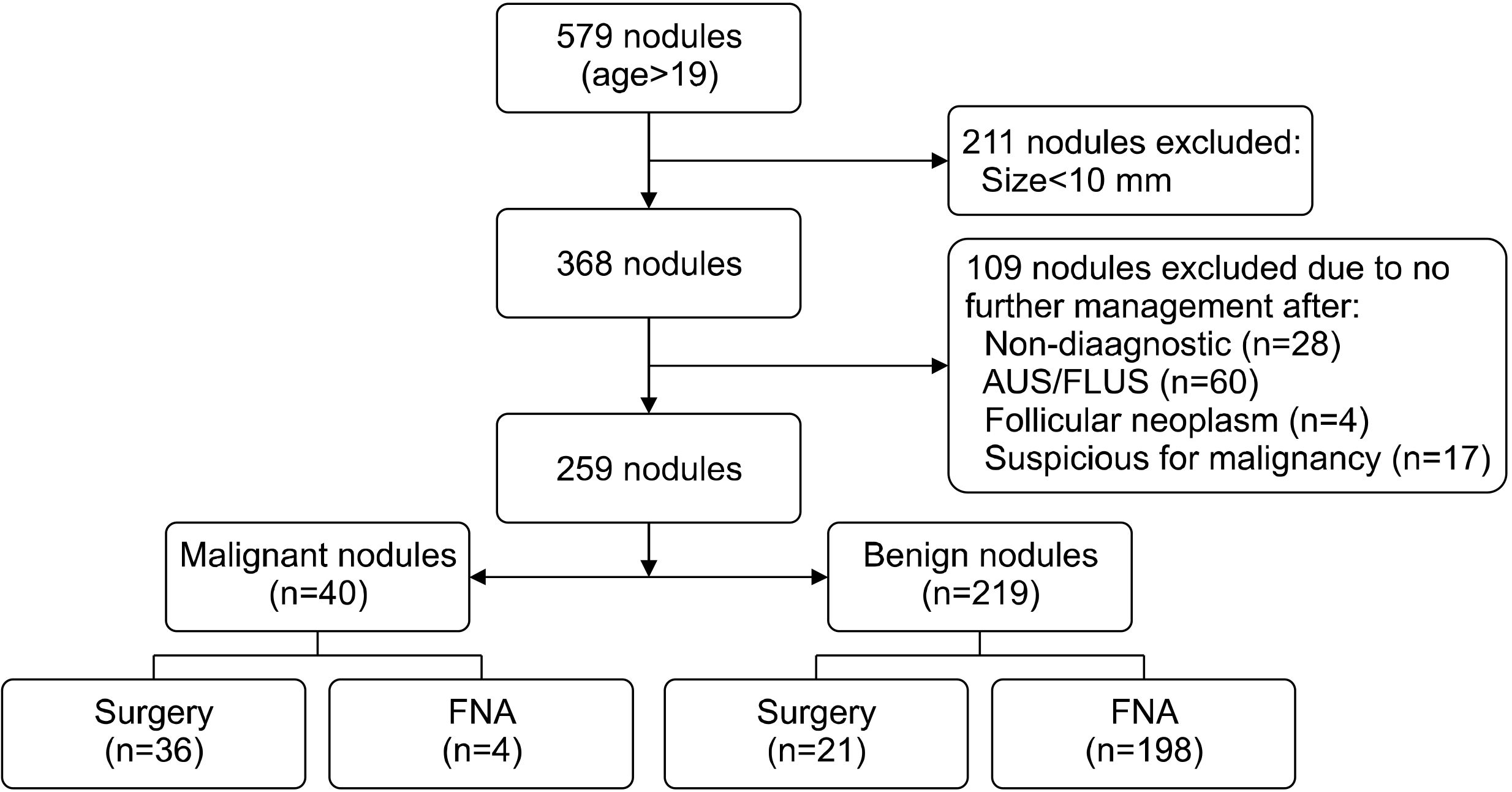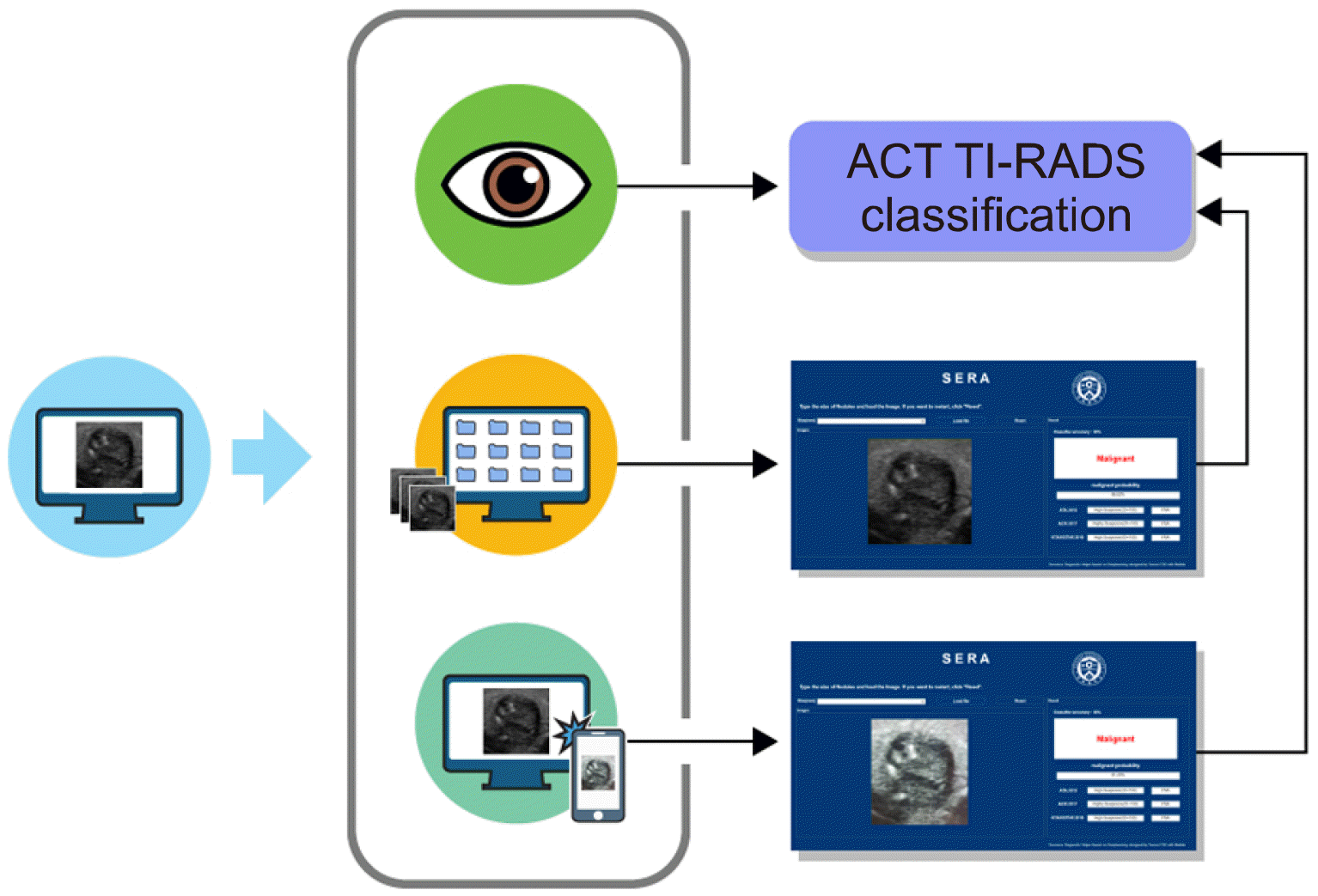1. Bray F, Ferlay J, Soerjomataram I, Siegel RL, Torre LA, Jemal A. Global cancer statistics 2018: GLOBOCAN estimates of incidence and mortality worldwide for 36 cancers in 185 countries. CA Cancer J Clin. 2018; 68(6):394–424. DOI:
10.3322/caac.21492. PMID:
30207593.

2. Choi SH, Kim EK, Kwak JY, Kim MJ, Son EJ. 2010; Interobserver and intraobserver variations in ultrasound assessment of thyroid nodules. Thyroid. 20(2):167–72. DOI:
10.1089/thy.2008.0354. PMID:
19725777.

3. Koh J, Kim SY, Lee HS, Kim EK, Kwak JY, Moon HJ, et al. 2018; Diagnostic performances and interobserver agreement according to observer experience: a comparison study using three guidelines for management of thyroid nodules. Acta Radiol. 59(8):917–23. DOI:
10.1177/0284185117744001. PMID:
29181988.
4. Gurcan MN, Boucheron LE, Can A, Madabhushi A, Rajpoot NM, Yener B. 2009; Histopathological image analysis: a review. IEEE Rev Biomed Eng. 2:147–71. DOI:
10.1109/RBME.2009.2034865. PMID:
20671804. PMCID:
PMC2910932.

6. Litjens G, Sanchez CI, Timofeeva N, Hermsen M, Nagtegaal I, Kovacs I, et al. 2016; Deep learning as a tool for increased accuracy and efficiency of histopathological diagnosis. Sci Rep. 6:26286. DOI:
10.1038/srep26286. PMID:
27212078. PMCID:
PMC4876324.

7. Liang X, Yu J, Liao J, Chen Z. 2020; Convolutional neural network for breast and thyroid nodules diagnosis in ultrasound imaging. Biomed Res Int. 2020:1763803. DOI:
10.1155/2020/1763803. PMID:
32420322. PMCID:
PMC7199615.

8. Esteva A, Kuprel B, Novoa RA, Ko J, Swetter SM, Blau HM, et al. 2017; Dermatologist-level classification of skin cancer with deep neural networks. Nature. 542(7639):115–8. DOI:
10.1038/nature21056. PMID:
28117445. PMCID:
PMC8382232.

9. Vandenberghe ME, Scott ML, Scorer PW, Soderberg M, Balcerzak D, Barker C. 2017; Relevance of deep learning to facilitate the diagnosis of HER2 status in breast cancer. Sci Rep. 7:45938. DOI:
10.1038/srep45938. PMID:
28378829. PMCID:
PMC5380996.

10. Zhang X, Lee VC, Rong J, Lee JC, Liu F. 2022; Deep convolutional neural networks in thyroid disease detection: a multi-classification comparison by ultrasonography and computed tomography. Comput Methods Programs Biomed. 220:106823. DOI:
10.1016/j.cmpb.2022.106823. PMID:
35489145.

11. Chi J, Walia E, Babyn P, Wang J, Groot G, Eramian M. 2017; Thyroid nodule classification in ultrasound images by fine-tuning deep convolutional neural network. J Digit Imaging. 30(4):477–86. DOI:
10.1007/s10278-017-9997-y. PMID:
28695342. PMCID:
PMC5537102.

12. Jin Z, Zhu Y, Zhang S, Xie F, Zhang M, Zhang Y, et al. 2020; Ultrasound computer-aided diagnosis (CAD) based on the Thyroid Imaging Reporting and Data System (TI-RADS) to distinguish benign from malignant thyroid nodules and the diagnostic performance of radiologists with different diagnostic experience. Med Sci Monit. 26:e918452. DOI:
10.12659/MSM.918452.

13. Youn I, Lee E, Yoon JH, Lee HS, Kwon MR, Moon J, et al. 2021; Diagnosing thyroid nodules with atypia of undetermined significance/follicular lesion of undetermined significance cytology with the deep convolutional neural network. Sci Rep. 11(1):20048. DOI:
10.1038/s41598-021-99622-0. PMID:
34625636. PMCID:
PMC8501016.

14. Koh J, Lee E, Han K, Kim EK, Son EJ, Sohn YM, et al. 2020; Diagnosis of thyroid nodules on ultrasonography by a deep convolutional neural network. Sci Rep. 10(1):15245. DOI:
10.1038/s41598-020-72270-6. PMID:
32943696. PMCID:
PMC7498581.
15. Kwak JY, Han KH, Yoon JH, Moon HJ, Son EJ, Park SH, et al. 2011; Thyroid Imaging Reporting and Data System for US features of nodules: a step in establishing better stratification of cancer risk. Radiology. 260(3):892–9. DOI:
10.1148/radiol.11110206. PMID:
21771959.

16. Quesada-González D, Merkoçi A. 2017; Mobile phone-based biosensing: an emerging "diagnostic and communication" technology. Biosens Bioelectron. 92:549–62. DOI:
10.1016/j.bios.2016.10.062.

17. Coleman B, Coarsey C, Asghar W. 2019; Cell phone based colorimetric analysis for point-of-care settings. Analyst. 144(6):1935–47. DOI:
10.1039/C8AN02521E. PMID:
30688961. PMCID:
PMC6411445.
18. Tessler FN, Middleton WD, Grant EG, Hoang JK, Berland LL, Teefey SA, et al. 2017; ACR Thyroid Imaging, Reporting and Data System (TI-RADS): white paper of the ACR TI-RADS Committee. J Am Coll Radiol. 14(5):587–95. DOI:
10.1016/j.jacr.2017.01.046. PMID:
28372962.

19. Fujimoto Y, Oka A, Omoto R, Hirose M. 1967; Ultrasound scanning of the thyroid gland as a new diagnostic approach. Ultrasonics. 5:177–80. DOI:
10.1016/S0041-624X(67)80065-9. PMID:
6053923.

20. Gallo M, Pesenti M, Valcavi R. 2003; Ultrasound thyroid nodule measurements: the "gold standard" and its limitations in clinical decision making. Endocr Pract. 9(3):194–9. DOI:
10.4158/ep.9.3.194. PMID:
12917060.

21. Kim GR, Lee E, Kim HR, Yoon JH, Park VY, Kwak JY. 2021; Convolutional neural network to stratify the malignancy risk of thyroid nodules: diagnostic performance compared with the american college of radiology Thyroid Imaging Reporting and Data System implemented by experienced radiologists. AJNR Am J Neuroradiol. 42(8):1513–9. DOI:
10.3174/ajnr.A7149. PMID:
33985947. PMCID:
PMC8367605.
22. Choi YJ, Baek JH, Park HS, Shim WH, Kim TY, Shong YK, et al. 2017; A computer-aided diagnosis system using artificial intelligence for the diagnosis and characterization of thyroid nodules on ultrasound: initial clinical assessment. Thyroid. 27(4):546–52. DOI:
10.1089/thy.2016.0372. PMID:
28071987.

23. Fawzy HED. 2015; The accuracy of mobile phone camera instead of high resolution camera in digital close range photogrammetry. Int J Civ Eng Technol. 6(1):76–85.
24. Blaivas M, Lyon M, Duggal S. 2005; Ultrasound image transmission via camera phones for overreading. Am J Emerg Med. 23(4):433–8. DOI:
10.1016/j.ajem.2004.09.037. PMID:
16032606.
25. Goost H, Witten J, Heck A, Hadizadeh DR, Weber O, Graff I, et al. 2012; Image and diagnosis quality of X-ray image transmission via cell phone camera: a project study evaluating quality and reliability. PLoS One. 7(10):e43402. DOI:
10.1371/journal.pone.0043402. PMID:
23082108. PMCID:
PMC3474770.

27. Luo LB, Chong JW. 2012; Real‐time digital image stabilization for cell phone cameras in low‐light environments without frame memory. ETRI Journal. 34(1):138–41. DOI:
10.4218/etrij.12.0211.0338.

28. Gampala V, Kumar MS, Sushama C, Raj EFI. 2020. Deep learning based image processing approaches for image deblurring. Proceedings;Materials Today:
29. Weinreich M, Chudow JJ, Weinreich B, Krumerman T, Nag T, Rahgozar K, et al. 2019; Development of an artificially intelligent mobile phone application to identify cardiac devices on chest radiography. JACC Clin Electrophysiol. 5(9):1094–5. DOI:
10.1016/j.jacep.2019.05.013. PMID:
31537342.

30. Cibas ES, Ali SZ. 2017; The 2017 Bethesda system for reporting thyroid cytopathology. Thyroid. 27(11):1341–6. DOI:
10.1089/thy.2017.0500. PMID:
29091573.








 PDF
PDF Citation
Citation Print
Print





 XML Download
XML Download